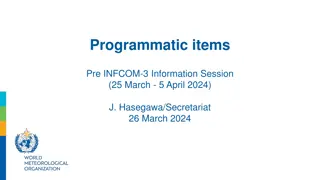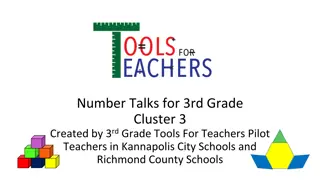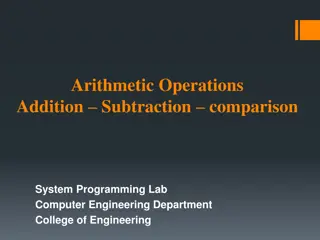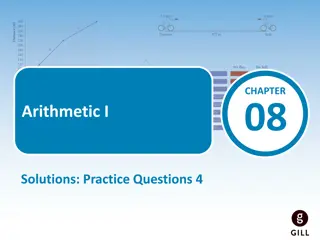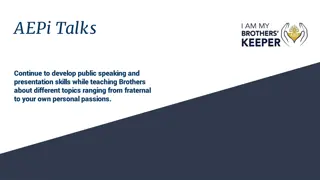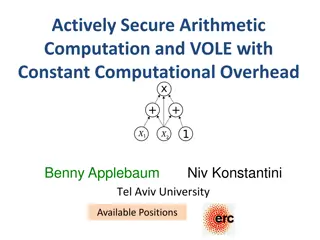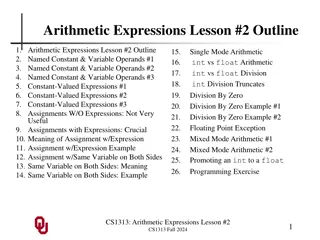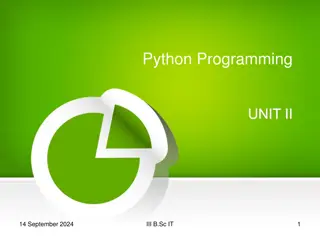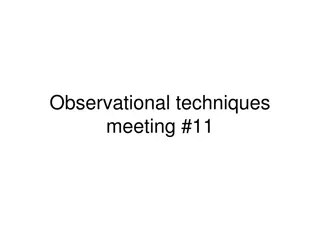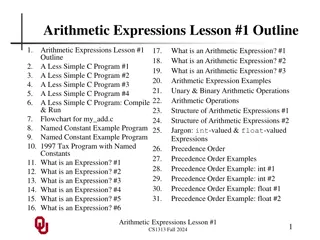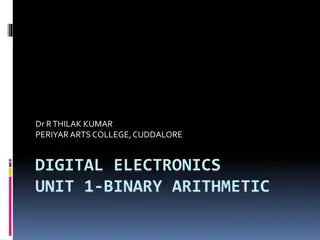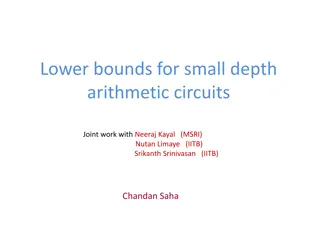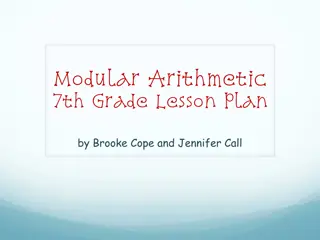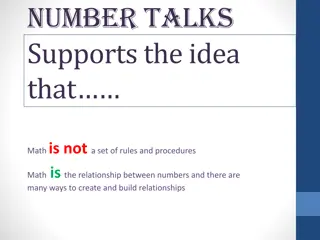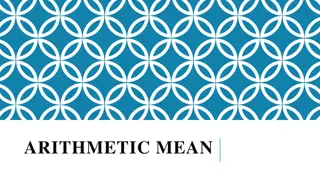eNICLE Grade 1 & 2 Programme Session - Arithmetic Strategies & Number Talks
This session focused on arithmetic strategies such as counting, early arithmetic, part-whole relationships, number sense, and efficient calculation methods. Additionally, Number Talks were introduced as a language-learning tool in mathematics education.
Download Presentation

Please find below an Image/Link to download the presentation.
The content on the website is provided AS IS for your information and personal use only. It may not be sold, licensed, or shared on other websites without obtaining consent from the author.If you encounter any issues during the download, it is possible that the publisher has removed the file from their server.
You are allowed to download the files provided on this website for personal or commercial use, subject to the condition that they are used lawfully. All files are the property of their respective owners.
The content on the website is provided AS IS for your information and personal use only. It may not be sold, licensed, or shared on other websites without obtaining consent from the author.
E N D
Presentation Transcript
eNICLE Grade 1 & 2 programme Session 5 13thMarch 2018 Prof Mellony Graven, Dr Debbie Stott, Dr Pam Vale, Ms Carolyn Stevenson-Milln, Ms Roxanne Long, Ms Samu Chikiwa
Recapping on 2017 Assessment Story books Part-part-whole Six Bricks evaluations by
COUNTING / EARLY ARITHMETIC STRATEGIES Tied to context tied to objects calculation by counting Counting by structuring using representations (physical & mental) 4 3 Learning to count How Many Synchronous (1-1 correspondence) Calculation by counting Calculating by structuring Formal calculating Count on / Count up to / Count down To overcome counting Using number relationships & what has already been learnt (number facts) for flexible calculation without need for structured representations / materials How? Count all Structure & number facts of 5 & 10 Doubles & near doubles Jump via 10 Jump of 10 Place value 0 1 2 visible items items Cannot count Items (from one: Counts visible Counts screened count all) Counters, fingers, physical objects Dot patterns, bead strings, 5-frames, no. lines up to 10 5 & 10-frames, bead strings, no. lines (to 20 & beyond) and part-part-whole model Learners need a sound base of quickly known or quickly derived number bonds The sevenness of seven becomes visible as a structure by visually seeing five (undivided) finger on one hand and tow on the other. This offers an opportunity to develop a part-whole relationship. Structuring numbers promotes number sense whereas counting single objects could lead to math- difficulties (Runesson and Kullberg 2010, p.4).
Number Talks Our story (1) Mathematics is a language, how do you learn a language? You learn to talk We heard about Number Talks from mathematical community We piloted them in a local school in 2014 Then rolled them out to all our NILCE teachers
Timing Section of talk Hand out cards to groups of learners Breathe and visualise Comments and instructions The Talk Plan 30 SECONDS Close eyes and visualise the pattern / sum on the card 30 SECONDS No touching (hands behind back) No writing (except for large multiplication problems) How many and how do you see them? OR Can you solve this problem? Think about how you will explain how you got your answer Whole class talk 30 SECONDS Use the PROMPT Use QUESTIONS TEACHER RECORDS VISUALLY (use coloured chalk if possible) Keep all records up so learners can see while watching / listening to others and see if their method is same / different Encourage use of hand signals Discuss the strategies contributed Which are more EFFICIENT? ACCURATE? As a class agree on the 2 most efficient strategies as key strategies Write FINAL STRATEGIES ON FLIP CHART to hang on class wall Whole class to point and say the 2 MOST EFFICIENT STRATEGIES 8 MINUTES Discussion of strategies 1 MINUTE Recap of efficient strategies 30 SECONDS APPROX 11 MINUTES
CLARIFY thinking INVESTIGATE and apply mathematical relationships Build a REPERTOIRE of efficient strategies Make decisions about choosing EFFICIENT strategies for specific problems Consider and TEST other strategies to see if they are mathematically logical During number talks, students are asked to communicate their thinking when presenting and justifying solutions to problems they solve mentally. These exchanges lead to the development of more accurate, efficient, and flexible strategies. The heart of number talks is classroom conversations focused on making sense of mathematics Why strategy talks?
Classroom environment and community Safe, comfortable, accepting Teacher practices blank face Classroom discussions Use of hand signals All answers correct and incorrect are recorded The teacher s role Move into roles of facilitator, questioner, listener, and learner Change question from, What answer did you get? to How did you solve this problem? Role of mental math When students approach problems without paper and pencil, they are encouraged to rely on what they know and understand about the numbers and how they are interrelated. Purposeful computation problems Crafting problems that guide students to focus on mathematical relationships Carefully planning is necessary Key Components of the talk
Your turn In your groups: Do one different number talk each as facilitator, others act as learners Choose from examples in your flip file: Dot cards 10-frames 10-frame multiplication Addition Subtraction Take 12 minutes per talk Record final methods on flip chart to hang on walls
Next month: 21st November End of year celebration Watch your SMS for details
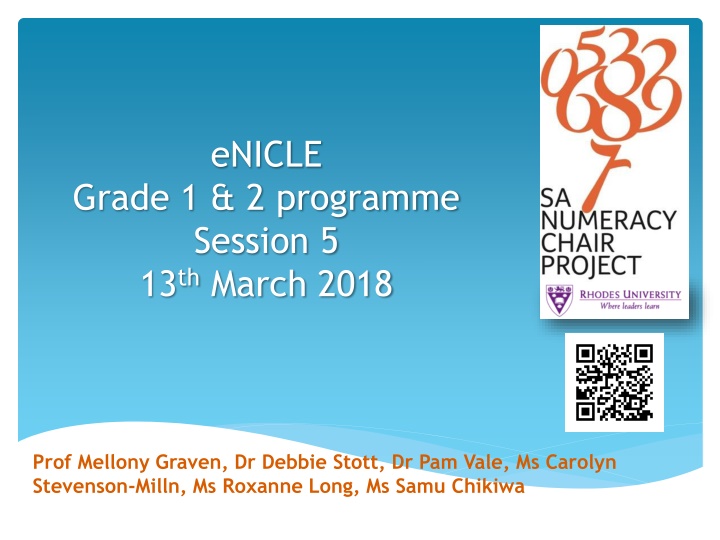

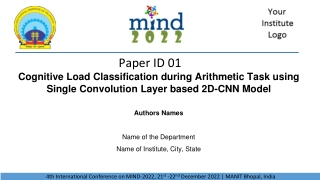
![❤[PDF]⚡ Civil War Talks: Further Reminiscences of George S. Bernard and His Fel](/thumb/20551/pdf-civil-war-talks-further-reminiscences-of-george-s-bernard-and-his-fel.jpg)
